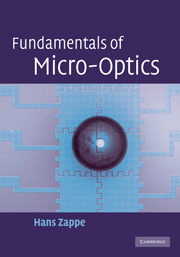Book contents
11 - Micro-optical fabrication
from Part II - Micro-optics
Published online by Cambridge University Press: 05 June 2012
Summary
A fool, Mr. Edgeworth, you know, is a man who never tried an experiment in his life.
Erasmus Darwin, 1792One of the distinguishing characteristics of micro-optics is the means by which micro-optical components and systems are fabricated. Classical optical elements, predominantly lenses and prisms, have been manufactured for centuries using well-established and highly refined grinding and polishing processes. As the size of lenses decreases below the millimeter range, however, these techniques reach their limits: grinding a lens with a diameter below 1 mm is difficult, and economically impracticable. As a result, micro-optics uses completely different fabrication techniques, namely those based on semiconductor manufacturing.
Semiconductor fabrication technology is extremely highly developed, and the factories that produce acres of processed silicon likely represent the most advanced manufacturing technologies on the planet. Whereas most of this industrial capacity is still used for generating the electronic chips on which much of human civilization relies, the past two to three decades have seen an expansion of these technologies into other realms, notably microelectromechanical systems (MEMS) (Menz et al., 2001; Senturia, 2001; Korvink and Paul, 2006; Liu, 2006; Gianchandani et al., 2007), a field that has diversified to include micromechanics, microfluidics, microacoustics and micro-optics. These sub-fields have benefited from semiconductor technology, not only in that extremely small structures may be defined but also that these may be mass-fabricated, in marked contrast to the fabrication of individual components that characterizes classical optics.
- Type
- Chapter
- Information
- Fundamentals of Micro-Optics , pp. 463 - 498Publisher: Cambridge University PressPrint publication year: 2010



